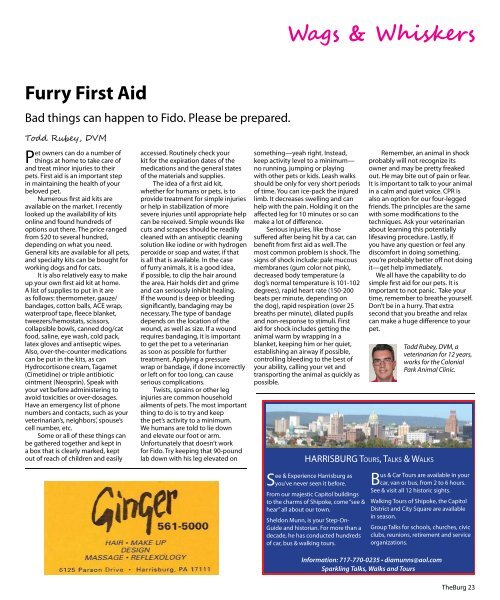Greater Harrisburg's Community Newspaper January 2010 - theBurg
Greater Harrisburg's Community Newspaper January 2010 - theBurg
Greater Harrisburg's Community Newspaper January 2010 - theBurg
Create successful ePaper yourself
Turn your PDF publications into a flip-book with our unique Google optimized e-Paper software.
Wags & Whiskers<br />
Furry First Aid<br />
Bad things can happen to Fido. Please be prepared.<br />
Todd Rubey, DVM<br />
Pet owners can do a number of<br />
things at home to take care of<br />
and treat minor injuries to their<br />
pets. First aid is an important step<br />
in maintaining the health of your<br />
beloved pet.<br />
Numerous first aid kits are<br />
available on the market. I recently<br />
looked up the availability of kits<br />
online and found hundreds of<br />
options out there. The price ranged<br />
from $20 to several hundred,<br />
depending on what you need.<br />
General kits are available for all pets,<br />
and specialty kits can be bought for<br />
working dogs and for cats.<br />
It is also relatively easy to make<br />
up your own first aid kit at home.<br />
A list of supplies to put in it are<br />
as follows: thermometer, gauze/<br />
bandages, cotton balls, ACE wrap,<br />
waterproof tape, fleece blanket,<br />
tweezers/hemostats, scissors,<br />
collapsible bowls, canned dog/cat<br />
food, saline, eye wash, cold pack,<br />
latex gloves and antiseptic wipes.<br />
Also, over-the-counter medications<br />
can be put in the kits, as can<br />
Hydrocortisone cream, Tagamet<br />
(Cimetidine) or triple antibiotic<br />
ointment (Neosprin). Speak with<br />
your vet before administering to<br />
avoid toxicities or over-dosages.<br />
Have an emergency list of phone<br />
numbers and contacts, such as your<br />
veterinarian’s, neighbors’, spouse’s<br />
cell number, etc.<br />
Some or all of these things can<br />
be gathered together and kept in<br />
a box that is clearly marked, kept<br />
out of reach of children and easily<br />
accessed. Routinely check your<br />
kit for the expiration dates of the<br />
medications and the general states<br />
of the materials and supplies.<br />
The idea of a first aid kit,<br />
whether for humans or pets, is to<br />
provide treatment for simple injuries<br />
or help in stabilization of more<br />
severe injuries until appropriate help<br />
can be received. Simple wounds like<br />
cuts and scrapes should be readily<br />
cleaned with an antiseptic cleaning<br />
solution like iodine or with hydrogen<br />
peroxide or soap and water, if that<br />
is all that is available. In the case<br />
of furry animals, it is a good idea,<br />
if possible, to clip the hair around<br />
the area. Hair holds dirt and grime<br />
and can seriously inhibit healing.<br />
If the wound is deep or bleeding<br />
significantly, bandaging may be<br />
necessary. The type of bandage<br />
depends on the location of the<br />
wound, as well as size. If a wound<br />
requires bandaging, it is important<br />
to get the pet to a veterinarian<br />
as soon as possible for further<br />
treatment. Applying a pressure<br />
wrap or bandage, if done incorrectly<br />
or left on for too long, can cause<br />
serious complications.<br />
Twists, sprains or other leg<br />
injuries are common household<br />
ailments of pets. The most important<br />
thing to do is to try and keep<br />
the pet’s activity to a minimum.<br />
We humans are told to lie down<br />
and elevate our foot or arm.<br />
Unfortunately that doesn’t work<br />
for Fido. Try keeping that 90-pound<br />
lab down with his leg elevated on<br />
something—yeah right. Instead,<br />
keep activity level to a minimum—<br />
no running, jumping or playing<br />
with other pets or kids. Leash walks<br />
should be only for very short periods<br />
of time. You can ice-pack the injured<br />
limb. It decreases swelling and can<br />
help with the pain. Holding it on the<br />
affected leg for 10 minutes or so can<br />
make a lot of difference.<br />
Serious injuries, like those<br />
suffered after being hit by a car, can<br />
benefit from first aid as well. The<br />
most common problem is shock. The<br />
signs of shock include: pale mucous<br />
membranes (gum color not pink),<br />
decreased body temperature (a<br />
dog’s normal temperature is 101-102<br />
degrees), rapid heart rate (150-200<br />
beats per minute, depending on<br />
the dog), rapid respiration (over 25<br />
breaths per minute), dilated pupils<br />
and non-response to stimuli. First<br />
aid for shock includes getting the<br />
animal warm by wrapping in a<br />
blanket, keeping him or her quiet,<br />
establishing an airway if possible,<br />
controlling bleeding to the best of<br />
your ability, calling your vet and<br />
transporting the animal as quickly as<br />
possible.<br />
See & Experience Harrisburg as<br />
you’ve never seen it before.<br />
From our majestic Capitol buildings<br />
to the charms of Shipoke, come “see &<br />
hear” all about our town.<br />
Sheldon Munn, is your Step-On-<br />
Guide and historian. For more than a<br />
decade, he has conducted hundreds<br />
of car, bus & walking tours.<br />
Remember, an animal in shock<br />
probably will not recognize its<br />
owner and may be pretty freaked<br />
out. He may bite out of pain or fear.<br />
It is important to talk to your animal<br />
in a calm and quiet voice. CPR is<br />
also an option for our four-legged<br />
friends. The principles are the same<br />
with some modifications to the<br />
techniques. Ask your veterinarian<br />
about learning this potentially<br />
lifesaving procedure. Lastly, if<br />
you have any question or feel any<br />
discomfort in doing something,<br />
you’re probably better off not doing<br />
it—get help immediately.<br />
We all have the capability to do<br />
simple first aid for our pets. It is<br />
important to not panic. Take your<br />
time, remember to breathe yourself.<br />
Don’t be in a hurry. That extra<br />
second that you breathe and relax<br />
can make a huge difference to your<br />
pet.<br />
HARRISBURG TO U R S, TA L K S & WA L K S<br />
Todd Rubey, DVM, a<br />
veterinarian for 12 years,<br />
works for the Colonial<br />
Park Animal Clinic.<br />
Bus & Car Tours are available in your<br />
car, van or bus, from 2 to 6 hours.<br />
See & visit all 12 historic sights.<br />
Walking Tours of Shipoke, the Capitol<br />
District and City Square are available<br />
in season.<br />
Group Talks for schools, churches, civic<br />
clubs, reunions, retirement and service<br />
organizations.<br />
Information: 717-770-0235 • diamunns@aol.com<br />
Sparkling Talks, Walks and Tours<br />
TheBurg 23









